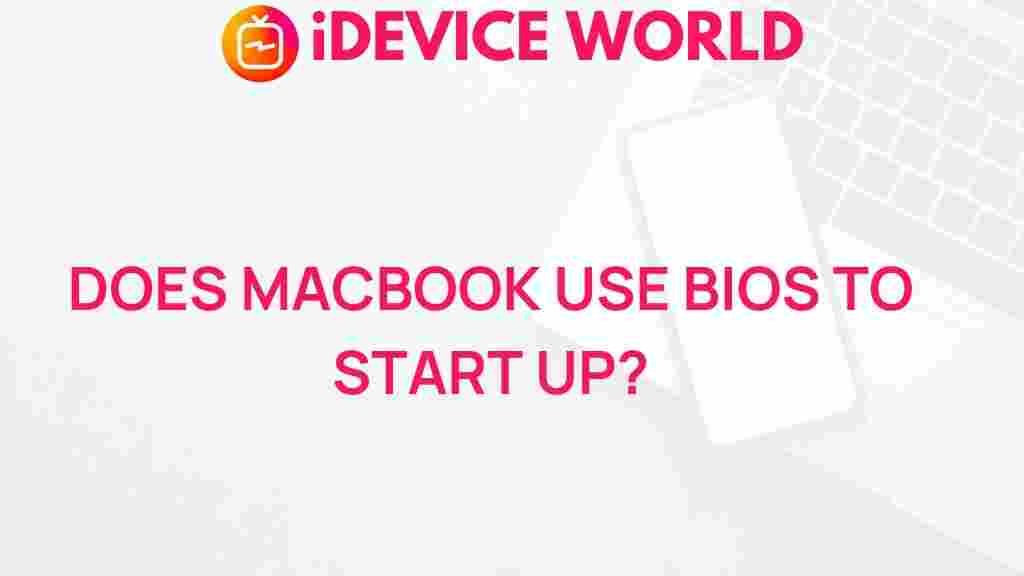Unraveling the Mystery: Does MacBook Rely on BIOS for Startup?
The MacBook is a sleek and powerful device that has captured the hearts of many users around the globe. As a result, understanding its internal workings is crucial for both potential buyers and current owners. One of the common questions that arise is whether MacBooks rely on a BIOS (Basic Input/Output System) for their startup process. This article delves into the intricacies of the MacBook’s startup mechanism, exploring its unique architecture and providing valuable insights for users.
Understanding the Basics: What is BIOS?
To grasp whether a MacBook uses BIOS, it’s essential to understand what BIOS is. Traditionally, BIOS is firmware that initializes and tests hardware components during the boot-up process before passing control to the operating system. This process includes:
- Power-On Self Test (POST): A diagnostic testing sequence that checks if hardware components like RAM and hard drives are functioning correctly.
- Loading the bootloader: The BIOS locates and executes the bootloader, which in turn starts the operating system.
However, BIOS is primarily associated with PCs running Windows. In contrast, Apple has developed its own system known as EFI (Extensible Firmware Interface).
EFI: The MacBook’s Alternative to BIOS
Instead of using a traditional BIOS, MacBooks utilize EFI, which was introduced in 2006. EFI serves a similar purpose as BIOS but with enhanced capabilities. Some advantages of EFI include:
- Support for larger hard drives: EFI can handle drives larger than 2 TB, a limitation with traditional BIOS.
- Faster boot times: EFI can perform boot processes more efficiently than BIOS.
- Enhanced security features: EFI includes options for secure boot, protecting the system against malware and unauthorized operating systems.
Overall, EFI is designed to be more flexible and powerful than its predecessor, making it better suited for modern computing needs.
How MacBooks Boot Up: A Step-by-Step Process
Understanding how a MacBook starts up requires a detailed look at the boot process. Here’s a breakdown of the steps involved:
- Power On: When you press the power button, the MacBook’s hardware components receive power.
- EFI Initialization: The EFI firmware initializes and tests the hardware components, similar to what BIOS does in a traditional system.
- Boot Manager: The EFI Boot Manager is responsible for displaying boot options, allowing users to choose between different operating systems or recovery modes.
- Loading the OS: Once an operating system is selected, the Boot Manager locates and executes the bootloader, which loads the operating system into memory.
- User Interface: Finally, the macOS interface loads, allowing the user to interact with the system.
The Role of SMC in the MacBook Startup Process
In addition to EFI, another crucial component in the startup process of a MacBook is the System Management Controller (SMC). The SMC is responsible for low-level hardware functions, including:
- Power management
- Battery management
- Thermal management
- LED indications
If you experience startup issues, resetting the SMC can often resolve them. Here’s how:
- Shut down your MacBook.
- Press and hold the Shift + Control + Option keys on the left side of the built-in keyboard, along with the power button.
- Hold these keys for 10 seconds, then release them.
- Press the power button again to turn on your MacBook.
Troubleshooting Startup Issues on Your MacBook
Even with advanced systems like EFI and SMC, MacBooks can experience startup issues. Here are some common problems and their solutions:
Problem 1: MacBook Won’t Start
If your MacBook fails to start, consider the following steps:
- Check power connections: Ensure the charger is plugged in and functioning properly.
- Reset the SMC: As outlined above, resetting the SMC can often resolve power-related issues.
- Boot into Recovery Mode: Press Command + R during startup to access recovery options and attempt repairs.
Problem 2: MacBook Stuck on Apple Logo
If your MacBook is stuck on the Apple logo during startup:
- Boot into Safe Mode: Hold the Shift key while booting to enter Safe Mode, which can help resolve software conflicts.
- Run Disk Utility: In Recovery Mode, use Disk Utility to check and repair the disk.
Problem 3: Kernel Panic
A kernel panic occurs when the operating system encounters an unexpected error. To troubleshoot:
- Disconnect any peripherals: Remove external devices to identify if they are causing the issue.
- Reset NVRAM/PRAM: Hold Option + Command + P + R during startup to reset these settings.
Enhancing Your MacBook Experience
To ensure your MacBook runs smoothly, consider the following tips:
- Regular Software Updates: Keep your macOS updated to benefit from the latest features and security enhancements.
- Monitor Storage Space: Regularly check your storage and clean out unnecessary files to maintain performance.
- Use Activity Monitor: Keep an eye on system resources to identify any applications that may be consuming excessive memory or CPU.
Final Thoughts
In conclusion, MacBooks do not rely on a traditional BIOS for their startup process. Instead, they utilize EFI, which offers several advantages, including faster boot times and enhanced security features. Understanding the intricacies of the MacBook’s startup process, including the role of the SMC, can empower users to troubleshoot issues effectively and enhance their overall experience. For more information about maintaining your MacBook, visit this helpful guide.
Whether you’re a long-time MacBook user or a newcomer to the Apple ecosystem, having a solid grasp of these fundamentals can significantly improve your experience. Don’t forget to stay informed about the latest updates from Apple to get the most out of your MacBook!
For more detailed technical specifications and support, visit the official Apple website at Apple Support.
This article is in the category Technology and created by iDeciveWorld Team
